Updated Version of 12/24/18 blog to correct errors
Advice for the Home Gardener from the Help Desk
UC Master Gardener Program of Contra Costa County
Client's Request: I would like to plant an avocado tree that has the following specifications: I live in West County where it is cool and foggy and I want a dwarf tree that is self-pollinating. Also, how far from my existing avocado tree can I plant my new tree?
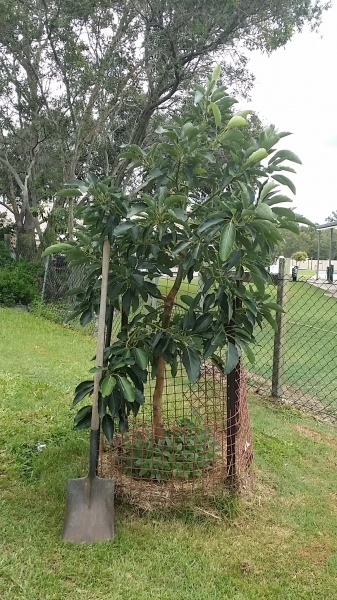
Persea americana "Wurtz"
Pollination: While avocado trees self-fertilize and produce fruit, yields should increase if both a Type A avocado tree and a Type B avocado tree are planted in order to increase the chances for successful pollination. The avocado tree has both functional male and female organs. The male floral organ (stamen) which produces pollen, is comprised of the anther and filament. The female floral organ (pistil) which receives the pollen, is comprised of the stigma style and ovary.
The avocado exhibits a type of flowering behavior known as “synchronous dichogamy.” An individual flower will open for two days and the timing of the male and female phases is distinct. There are two flowering types, referred to as “A” and “B” flower types. “A” varieties open as female on the morning of the first day. The flower closes in late morning or early afternoon. The flower will remain closed until the afternoon of the second day when it opens as male. “B” varieties open as female on the afternoon of the first day, close in late afternoon and re-open in the male phase the following morning. This flowering behavior is believed to promote cross-pollination since the male and female phases of an individual tree occur at different times. It is believed that the interplanting of complimentary flower types can boost fruit set and yield by making pollen more available.
The following identifies common varieties for each flowering type:
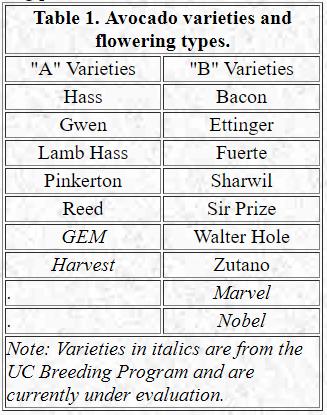
Table 1 of http://ucavo.ucr.edu/Flowering/FloweringBasics.html
You mentioned that you have an existing avocado tree. If you know which flowering type your tree is, then plan to plant another tree of the other flowering type, so you will be more successful in cross-pollinating both trees.
You also asked how far apart to plant the two trees. You can plant the new tree anywhere in the yard and cross-pollination should occur. Depending on the size of your existing tree, be aware that you don't want to plant the new tree in the shadow of the existing tree. Here is a link that provides information on avocado tree flowering behavior:
http://ucavo.ucr.edu/Flowering/FloweringBasics.html
In general, avocado trees do best at moderately warm temperatures (60‒85 degrees F.) with moderate humidity. Optimum fruit set occurs from 65‒75 degrees F. Cooler or warmer temperatures are less ideal. They can tolerate temperatures, once established, of about 28‒32 degrees F with minimal damage. Plant your tree in March through June. If you plant during the summer, there is always the risk of sun damage, because avocado trees don't absorb water very well when they are young. Plant in a spot protected from wind and frost, and planting in full sun is best. The avocado is a shallow-rooted tree with most of its feeder roots in the top six inches of the soil, so give it good aeration. Its root system is very sensitive, and great care should be taken not to disturb it when transplanting. Avocado trees like the pH of the soil to be about 6‒6.5. If you have heavy clay soil, elevate the tree in a mound for better drainage, making the mound 1‒2 feet high and 3‒5 feet around. Here is a link with information on growing avocado trees:
http://homeorchard.ucanr.edu/Fruits_&_Nuts/Avocado/
In my research for finding a type of dwarf avocado tree, I found this link:
http://mgorange.ucanr.edu/Edible_Plants/?uid=127&ds=530
The Wurtz avocado tree (flowering type A) is sometimes referred to as Little Cado and it is the only true dwarf variety of avocado. It will consistently produce good fruit from May to September. Compared to other avocado trees which can grow up to 80 feet, a Wurtz grows to about 10 feet. It is a hybrid created from the Mexican and Guatemalan avocado species, and produces abundant fruits within one to two years of planting if it is a grafted tree. Grown in the right conditions, and properly cared for, a Wurtz avocado tree will do well in mild-winter areas of California. While it can tolerate temperatures as low as 25 degrees F, it should be kept in a warm environment with protection against strong winds and frost. A young tree, one that is less than 12 months old, requires shelter from direct summer sunlight or the stems and bark will burn. If its trunk is exposed to sun, it will also be important to protect it from sunburn by painting it with a 50:50 mix of white interior latex paint and water. After several years the tree will grow enough foliage to shade itself from the sun.
If the Wurtz avocado tree is cared for properly, it will start growing flowers for pollination sometime between January and March within one to two years of planting (if it is a grafted tree). Purchasing a grafted tree from a nursery is the easiest way for the home gardener to have a fruit-bearing tree. Once the flowers are pollinated, the Wurtz bears fruit that ripens between May and September. The fruits are dark green and medium in size ranging from 6‒12 ounces. They have thin, shiny skins with a small seed. The fruits have been rated by growers as having a good and consistent flavor with an oil content of 16%. Avocados will not ripen while still on the tree. Harvest when fruits are of mature size and still firm. They will ripen in one to two weeks at room temperature.
Good luck in growing your next avocado tree and let us know if you have any further questions.
Help Desk of the UC Master Gardener Program of Contra Costa County (BY)
and Allen Buchinski for correcting the original's copy errors and the editor's misses.
Note: UC Master Gardeners Program of Contra Costa's Help Desk is available almost year-round to answer your gardening questions. Except for a few holidays (e.g., last 2 weeks December), we're open every week, Monday through Thursday for walk-ins from 9:00 am to Noon at 2380 Bisso Lane, Concord, CA 94520. We can also be reached via telephone: (925) 608-6683, email: ccmg@ucanr.edu, or on the web at http://ccmg.ucanr.edu/Ask_Us/. MGCC Blogs can be found at http://ccmg.ignore.edu/HortCoCo/ You can also subscribe to the Blog.
Advice for the Home Gardener From the Help Desk of the
UC Master Gardener Program of Contra Costa County
Client's Situation and Request: We have a male and female avocado tree likely ~2.5 years old (we moved to our new home in Moraga, CA ~1.5 years earlier) adjacent to each other on a slope. This past year, there was only one fruit albeit the size of a man's palm (greenish-black, Hass?). This year, although there were several hundred blossoms, the tree again bore one fruit. Presumably because of heavy rains early in the year (~60-inches per the St Mary's weather station), the leaves turned yellow/spotted black and fell off...but we do currently have a profusion of large green leaves. So what do I need to do to increase crop? is it a fertilization issue and/or inadequate N application? or is it the young age of the trees? Your feedback would be much appreciated as we were planning on planting more of the dwarf variety during Spring.
MGCC Help Desk Response: Thank you for contacting the UC Integrated Pest Management (IPM) Program with your avocado questions. They have referred your questions to us at the UC Master Gardener Program of Contra Costa County.
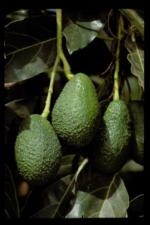
Another contributing factor, as you noted, was the timing of rain last spring, which could have damaged the flowers.
Another factor is simply the complexity of the pollination process in avocados. Avocado trees are not male or female, but having two compatible trees should lead to fruit production, if other factors you have mentioned are also favorable. Avocados have a type of flowering behavior known as "synchronous dichogamy" where the same flowers open in female and male forms at different times over 2 days. When flowers first open they are in the female phase. At the end of the female phase, which only lasts 2 to 4 hours, the flowers close. On the next day, flowers reopen as male and shed their pollen. To complicate matters even further, the time of day when the avocado flowers open depends on the variety. That is why avocado trees are typically planted in pairs and usually require a pair with one each from a "Type A" and "Type B" variety. For more information on avocado flowering and a table of complementary "Type A" and "Type B" varieties, see http://www.ucavo.ucr.edu/Flowering/FloweringBasics.html This complementary pairing should be a prime consideration for success if/when you plant more avocados, especially if you don't know your current avocado varieties.
You also asked about fertilization. Young avocado trees do need fertilization, primarily in the form of nitrogen. Three year old trees would need around 1/2+ pound of actual nitrogen per year. The nitrogen could be applied spread over 3 to 4 applications during the year. For information on fertilizing avocados considering age of the tree, please see http://ipm.ucanr.edu/PMG/GARDEN/FRUIT/CULTURAL/avocadofert.html Note that while fertilization is important for the health of the trees, it will not counteract the possible pollination problems that you likely encountered.
For more information on growing avocados, you may also want to check out the cultural information and FAQs at this site: http://www.ucavo.ucr.edu/General/Answers.html#anchor1425068
Another good source of information on the growing and care of avocados is the California Rare Fruit Growers: https://www.crfg.org/pubs/ff/avocado.html.
You also mentioned that the leaves turned yellow and black and then dropped off last winter. That could have been from rain, but may have also been problems with insects or a form of root rot. Please get back to us if this happens again, so that we can help identify the problem.
One final note is that avocados are tropical trees that prefer temperatures in the 60 to 85 degree Farenheit range. While many varieties can tolerate temperatures outside that range, you may have trouble with the cold temperatures in Moraga. The fact that your trees were planted on a hillside could be an advantage for drainage and, if you are in a sheltered area, they may do well. The successful avocado growers usually are a combination of appropriate variety and the planting and protecting the tree from cold. If you are going to plant more avocados this spring, we suggest you especially consider varieties that can tolerate the colder temperatures of Moraga.
Finally, welcome to the “cult” of the home avocado gardener. Despite all the troubles trying to grow avocados in our less than tropical climate, there are always home gardeners who have successfully grown them. With some appropriate planning and care that will be you.
Good luck with your avocados.
Please let us know if you have further questions or want additional information.
Help Desk of the UC Master Gardener Program of Contra Costa County (ECS)
Note: The UC Master Gardeners Program of Contra Costa's Help Desk is available year-round (except the last two weeks of December) to answer your gardening questions. Except for a few holidays, we're open every week, Monday through Thursday for walk-ins from 9:00 am to Noon at 75 Santa Barbara Road, 2d Floor, Pleasant Hill, CA 94523. We can also be reached via telephone: (925)646-6586, email: ccmg@ucanr.edu, or on the web at http://ccmg.ucanr.edu/Ask_Us/ MGCC Blogs can be found at http://ccmg.ucanr.edu/HortCoCo/ You can also subscribe to the Blog (http://ucanr.edu/blogs/CCMGBlog/)
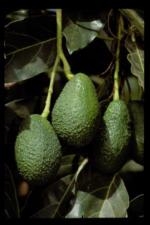
Help for the Home Gardener from the CCMG Help Desk
Client's Questions and Problems: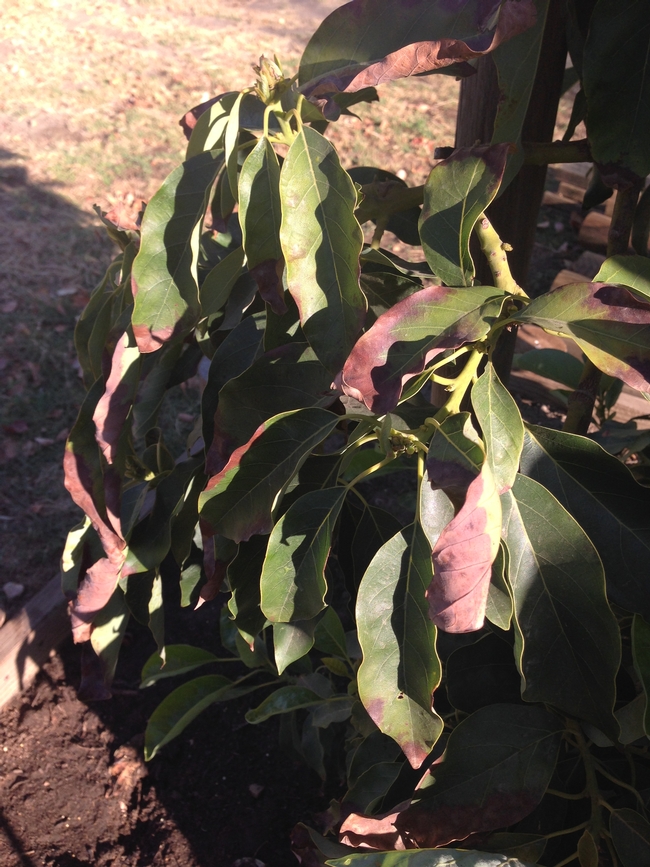
with some webbing as well as some “corky” bark. He also said they have “red ants” on the tree which bite when handled. The container is large, and consists of a mixture of native (clay) soil and amendments. He has poor drainage in his yard hence the need for container. Has plans to plant another variety (Zutano) so will have the A and B pollinators. Varieties are compatible and appropriate for his area. Client uses well water and is close to Discovery Bay and knows about their boron problem, but his well seems fine although he has not taken a recent water test.
CCMG Help Desk Initial Response:
Thank you for calling Master Gardeners with your Avocado problems. The e-mailed photos came through well. Based upon the information so far, we think the most likely cause of the brown areas on the leaves is sunburn and/or windburn. You may have noticed that the affected leaves are mostly on the top and outside of the plant, and there are many unaffected leaves. We have had a few really hot days in recent weeks (these questions and responses are in mid-September). You can provide some temporary shade using a light shade cloth or some other shade structure on hot afternoons - although hopefully we will not have too many more of those to come this year. Also, avocados are quite sensitive to wind, so if they are in a windy area some protection from wind might help. You mentioned that the tree is getting adequate water, and from the photos I did not see problems related to well water - although it may be helpful to get that tested if you see other plants in your garden developing problems. I did see some webbing on the leaves, but it does not seem to be widespread in the tree. I could not tell from the photo if there were insects present, but it could be spider mites, and if this insect presence is only in a small area of the tree, you can wipe them off or use a quick water spray. I am including some UC links which will give some more information on pests and on avocados in general. http://ipm.ucdavis.edu/PMG/GARDEN/FRUIT/avocados.html and http://ipm.ucdavis.edu/PMG/PESTNOTES/pn7405.html
You also mentioned that you had a colony of 'red ants'. Without seeing these I cannot tell you what they are; red fire ants have been found in southern California, and I have not heard reports of them being in the Bay Area, but that does not mean you don't have them. What you are seeing could be red Spider Mites. Here is a link that might help-http://ipm.ucdavis.edu/PMG/PESTNOTES/pn7487.html
If you would like a positive identification on these ants, you could bring a sample into the Agricultural Commissioner's office, of which there is a branch in Knightsen. This link gives their hours and contact information.
http://www.co.contra-costa.ca.us/1542/Agriculture-Weights-Measures
Finally, here are some further links to general avocado culture. The second one has some good information on growing in containers. http://ucanr.org/sites/gardenweb/files/29079.pdf
and http://uccemg.com/Edible_Plants/?ds=530&uid=127
I hope this is helpful, and that you will eventually grow some good avocados.
******************************************************************
CCMG Help Desk Follow-up Response:
After we spoke earlier today, I did some research and learned that avocados are very sensitive to high salt (chloride) and boron levels in irrigation water. Symptoms of chloride toxicity include chlorosis (yellowing) of leaves and necrosis (death) of the tips and margins (edges) of leaves. Symptoms are usually more severe on the older leaves. Boron toxicity causes dark, necrotic areas along the edges of leaves.
Here is a University of California photo that shows how boron toxicity appears on an avocado (left). The right photo shows chloride toxicity effects on an avocado.
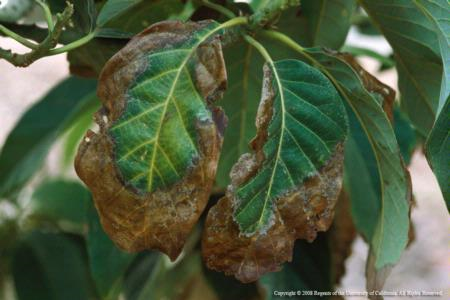
Boron Toxicity
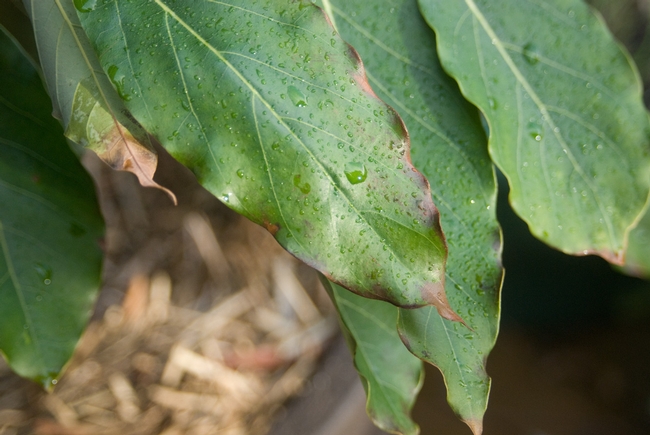
Chloride Toxicity
The damage on the leaves in these photos look similar to those in the photos you sent previously, so it does seem possible that high levels of salt or boron in the irrigation water could be causing the leaf problems you are seeing on the tree. It is probably worthwhile for you to have the water tested for the well you are using to irrigate the tree. There is the possibility that the drought, or increased (or decreased) pumping of other nearby wells, or changed irrigation practices have affected the quality of your well water.
A list of commercial laboratories that perform water testing can be found at this link on the CCMG web page (http://ccmg.ucanr.edu/files/77177.pdf). You will want to have the water tested for irrigation suitability. It is sometimes hard to navigate the websites for the testing labs and to find a description of the services offered and the charges for the testing they can perform. You might find it easier to call the labs to get the information you need. Be sure to call several before you decide which one to use since the fees charged seem to vary quite a bit. I found a couple that charge only about $75 for the irrigation water test, but some charge twice that much.
Below is an excerpt from tables from the University of California publication entitled "Abiotic Disorders of Landscape Plants" (the original reference document's Table of Contents is at http://www.fao.org/docrep/003/T0234E/T0234E00.htm#TOC) that you might find helpful in understanding the results of your well water test. The data from the tables show maximum levels of salts (chloride) and boron in irrigation water that are generally considered safe. Because the avocado is quite sensitive to boron and salts, any amounts in your well water that are higher than the levels shown below n the table as “generally safe” could cause problems for the tree. If you have the water tested and would like some assistance in interpreting the results, you are welcome to contact us for help.
****************************************************************
Relative Boron Tolerance of Avocadoes: Sensitive @ 0.5 - 0.75 mg/l
****************************************************************
Maximum Permissible Chloride Without Avocado Leaf Injury from Different Rootstock
Root Stock Root Zone (Cle) (me/l) Irrigation Water (Clw) (me/l)
West Indian 7.5 5.0
Guatemalan 6.0 4.0
Mexican 5.0 3.3
****************************************************************
On a different topic, I looked again at the photos showing the rough, “corky” areas on the bark of the tree. It does look somewhat unusual, but I couldn't identify any likely causes. When I tried to enlarge the photo to look closer at the corky areas, the photo became blurry. If you want us to investigate further, perhaps you could send us a “close-up” photo. Also, one possibility that occurred to me is that it might be sun scald. You might want to check to determine whether the side of the tree that receives the most direct sunlight shows more of the rough corky areas as compared to more shaded areas. If the answer is “yes”, it could point to sun scald.
Hope you find this additional information to be helpful. Feel free to call us again if you have additional questions.
******************************************************************
Contra Costa Master Gardeners' Help Desk
Editor's Note: The Contra Costa Master Gardener Help Desk is available year-round to answer your gardening questions. Except for a few holidays, we're open every week, Monday through Thursday from 9:00 am to Noon at 75 Santa Barbara Road, 2d Floor, Pleasant Hill, CA 94523.
We can also be reached via telephone: (925) 646-6586, email: ccmg@ucanr.edu, and we are on the web at http://ccmg.ucanr.edu/

